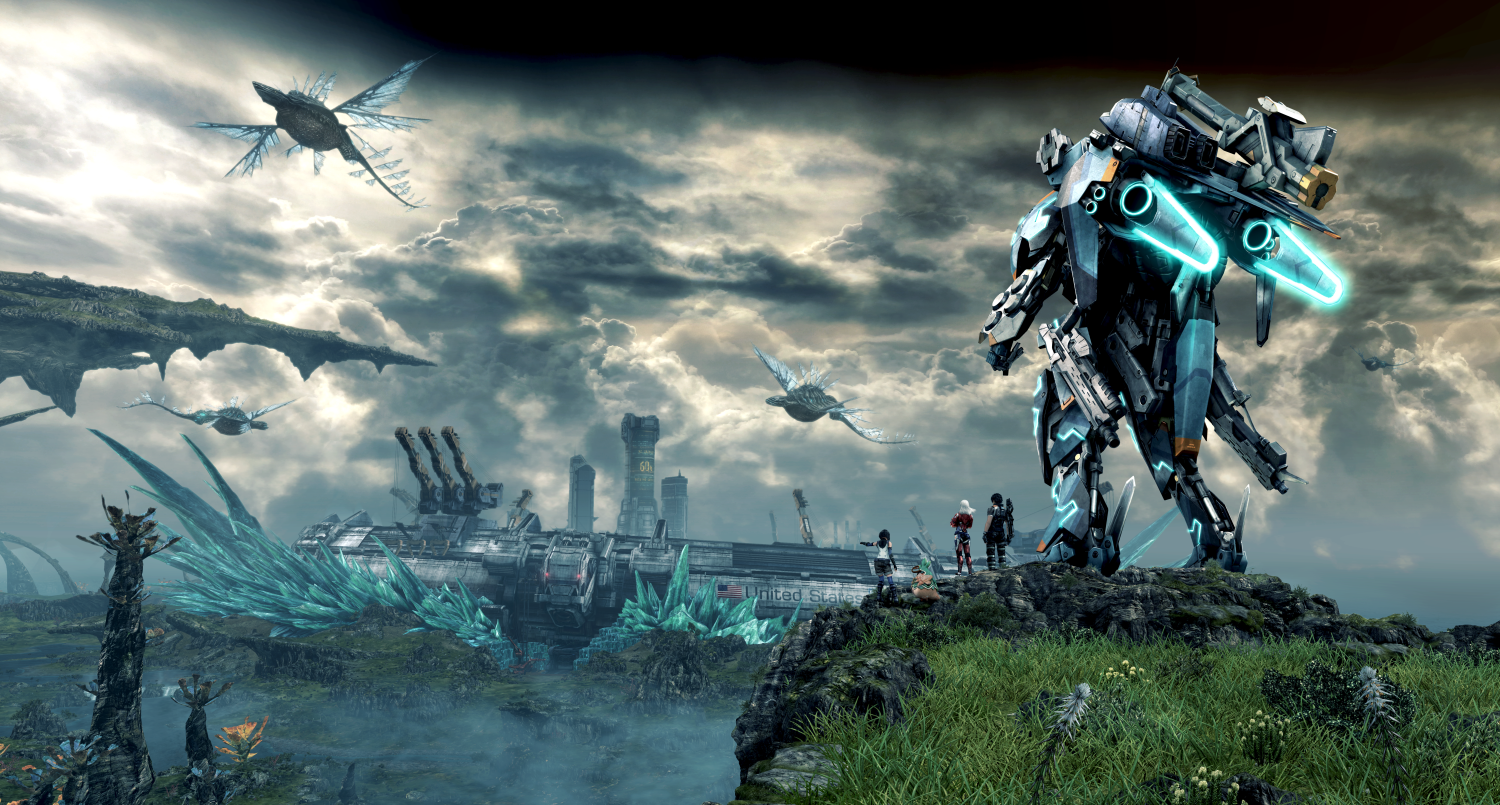If you are looking to compare Xenoblade Chronicles X to its Wii predecessor, you will be disappointed. XCX is not a bad game by any means, and it is certainly cut from the same cloth as the Wii’s sleeper hit, but in the end, XCX is a completely different beast.
XCX’s story is more concerned with the entirety of New Los Angeles, rather than a core group of protagonists. Following the crash of the White Whale, the members of BLADE must search for the remains of the Lifehold, which holds their fellow passengers; the remaining survivors of the human race. You can expect to see Elma, Lin, and Tatsu in nearly every chapter, but there are quite a few more characters for players to discover; each with their own stories and motivations. Instead of the simple heart-to-hearts, players will need to go on affinity quests with characters to learn more about what makes them tick. The main story is presented in chapters that have a definite beginning, middle, and end. Unfortunately, you won’t get a sense on how the story is progressing through the storytelling itself, but through the mission details that pop up, (e.g. Chapter 3 Part 3/5). Relegating the story chapters to mission statements downplays its significance, which is a shame, because Monolith Soft still knows how to set up intrigue and suspense.
Starring in XCX is a character of your creation, rather than a character with a pre-established connection to fellow cast members. Surprisingly, in contrast to all of the choices and options in the game, how you customize your character is limited. Sure, your skin can be one of sixty colors, but how you style your hair is down to only around ten choices; the eyes and facial structure have around the same amount of options. While you can choose a voice for your character, don’t expect to hear a peep out of them outside of battle. Instead, your characters dialogue is limited to shakes, nodes, and empathetic arm movements, followed by a more verbose character providing the translation.
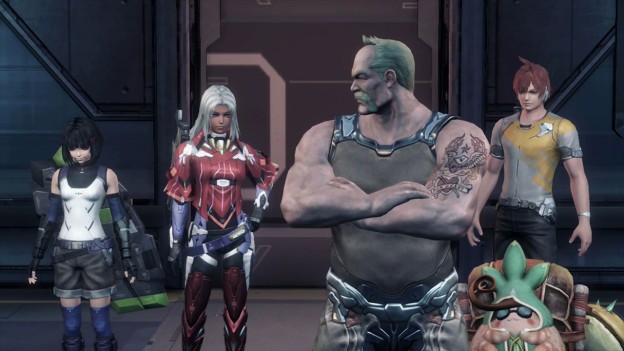
Anyone who grew up watching Lassie may feel just a bit nostalgic
The result is that your custom character feels much more along for the ride. When choices need to be made during cut-scenes, the scene is paused so the player can make their response. This Zack Morris-esque break completely breaks the immersion and pacing, and can take away a lot of emotional power in scenes. Without spoiling, there is one scene in particular that would have benefited incredibly from the vocals of our silent hero.
While main story may have taken a hit, side quests have been given a bit more TLC. Many of the quests themselves are still the same (kill these things, gather those things, you know the drill), but many quests are preceded and concluded with quick cut-scenes, which make the residents of NLA that much more fleshed out and important, rather than a sea of NPCs floating in the background of the real story. Giving players something to fight for also heavily breaks up the monotony that plagues so many RPGs and jRPGs; I didn’t make it to level fifty by fighting Duogouls and Prone a thousand times, I made it to level fifty because I had to solve a murder case, or save a fellow BLADE from a giant bird, or uncover a conspiracy.
Most quests have objective markers, pointing out where players need to travel. In any other game, objective markers can make quests boring, and more of a chore than an adventure, but given the sheer size of each continent, the objective markers feel like a necessary evil; this makes things all the more frustrating when suddenly, the marker is nowhere to be found. I’ve spent hours searching for a certain type of indigen (read: monster) because, for reasons unknown to me, the game did not want to tell me where they lived. Only after a three-hour hunt did I finally track those things down and finish the quest. That issue was sign of things to come, as my progress screeched to a halt during an affinity quest while searching for something that is a third the size of a human. The only clue I had to its whereabouts was “somewhere in the forest”.
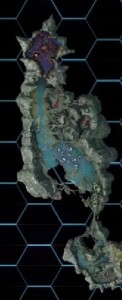
Pictured: Forest
Now, I am perfectly willing to admit that maybe I’ve overlooked something, but I spent ten hours searching the continent of Noctilum for this one single thing. The objective never changed when I found out I needed to seek out this tiny thing, nor did the marker move away from my previous objective, so I wasn’t even sure the quest activated properly. Even worse, I could not continue the story without first completing the affinity quest, so I was trapped. Eventually, I cut my loss, and restarted the game; I was forty hours into the game at the time.
This brings me to another warning about Xenoblade Chronicles X, everything you do will reside in one single save file, ala Pokémon. Given the massive size of this game, having multiple save files should be natural. At the very least, multiple save files could have rescued me from that affinity quest debacle. Looking at the silver lining, restarting the game gave me a chance to approach the game using different classes and divisions.
In my first runthrough, I was Pathfinder, a group dedicated to expanding FrontierNet, your interactive map, and main means of travel throughout the five continents. This time around, I am under the Interceptors, who thrive in a fight. Each division can give out different bonuses to yourself and others online during battle, which could give you that essential edge in a heated brawl. Aside from these bonuses, my run-throughs did not have many major differences. Battles never felt any easier or harder depending on my division. You’ll still want to expand FrontierNet as much as possible while installing probes to increase the amount of materials you acquire, your paycheck, and creating more fast-travel points. Otherwise, what truly matters will be the classes you choose as you progress through the game.
The central pillar of Chronicle X’s battle system is the class system; by far the strongest element in XCX. Mastering the various classes adds to the arts and skills available to players. After being unlocked, arts are less dependent on class themselves, and are tied to certain weapons (e.g. knife art, sword art, rifle art). Having certain combinations of arts can effect everything on how you support your comrades, cripple the enemy, or even the pace at which you auto-attack. There is no one single class that is perfect for every job, lending excitement to every battle and keeping the gameplay fresh even after dozens of hours into the campaign.
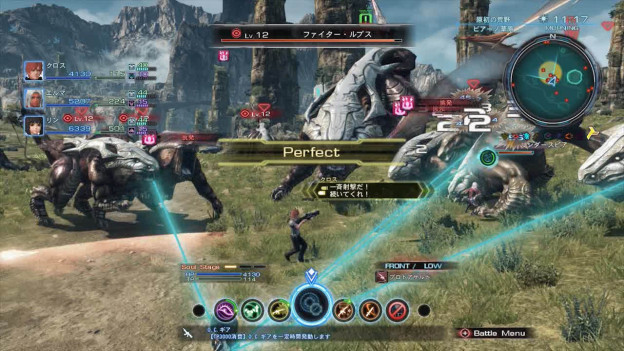
Aside from arts, characters will also learn new skills from leveling up their classes. Whereas arts are active in battle, skills are passive perks, that can give your character an essential edge. Like arts, characters can only activate so many skills at once, preventing them from becoming a powerhouse. Both arts and skills can be upgraded using battle points, but the cost essentially doubles after each upgrade. Since the BP pool is shared, you’ll have to think carefully on how you want to spend your points. Newcomers to jRPG’s may be put off by all of the numbers and stats that XCX throws at them, but rest assured that the class system is easy to grasp after enough hours – good to know, since Monolith Soft has introduced a small (about 40 feet) edition to their active combat system: Skells.
It’s a shame that you won’t have a Skell until after chapter 6, and even longer before you can take to the skies. There is something very cathartic about being in a giant robot while duking it out against equally giant monsters. You can even feel an uptick in a character’s emotions while they sit in the pilot’s chair, which only adds to the urgency and excitement that comes with giant robot fighting. Combat itself has a few key changes as well. Instead of a technical point pool, your arts consume fuel, which is replenished by Miranium (I hope you’ve been mining), or by simply spending enough time outside of your Skell. Arts are tied to equipment, but the vast majority consist of either melee or gun arts, restricting the variety found in pedestrian combat. You can try combat with only some of your party in skells, but since skell combat is typically called for in battles against colossal foes, woe to the poor sap you decided to send in on foot.
Once you reach a certain continent, your skell will start to feel like a hummer…in Europe. If you’re not flying, you’re fighting, and within the hour, your skill will be flying on fumes. Since refueling 3000 gallons costs a staggering 5000 Miranium, just one gas stop will bleed you dry. Playing for more than a few hours will be sure to completely drain your miranium bank. The climactic dogfights are fun, but the aforementioned gas prices severely limit your experience in what is one of the prime selling points of Xenoblade Chronicles X.
Speaking of prime selling points, the world of Mira shrinks significantly inside a giant robot. Although some may see this as a setback, Mira feels large enough on foot, and further extensions would make exploring feel more tedious than rewarding. When you add flight to a game heavily reliant on exploration, it feels like the only way to go is up, but XCX doesn’t often take advantage of the third dimension. There are a few islands and underground caves here and there, but they never extend past a few rooms; suddenly, the gargantuan world of Mira becomes a little bit smaller.
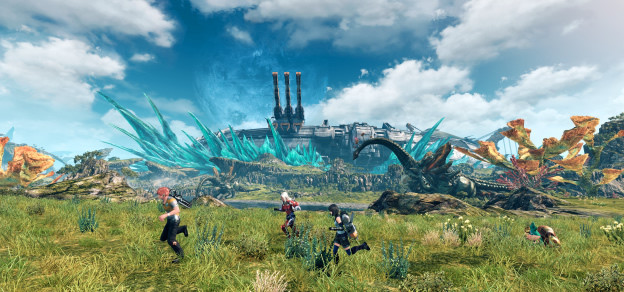
It is fitting to know that my longest review has gone to describe the largest game I have ever been assigned. There is still a lot to unpack about Xenoblade Chronicles X, but the game’s strengths and weaknesses have made themselves apparent. Monolith Soft was certainly ambitious when crafting their latest jRPG, with varying degrees of success. The world is huge, and flows seamlessly, but Planet Mira certainly hid less secrets from me than I was hoping. Whether fighting or questing, there are plenty of tasks outside the usual grind and level. Unfortunately, keeping a tight leash on the story quests really hurt the storytelling. Anyone looking for a world to immerse themselves in for weeks, or even months, may want to look into picking up Xenoblade Chronicles X, but be warned that the only Monodo in this game is the beret in Lin’s hair.
Review: Xenoblade Chronicles X [Full]
Amazing

